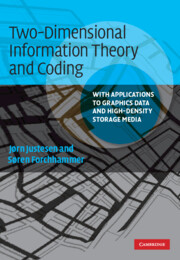 Two-Dimensional Information Theory and Coding
Two-Dimensional Information Theory and Coding Published online by Cambridge University Press: 05 June 2012
Introduction
In this chapter we present some of the basic concepts of information theory. The situations we have in mind involve the exchange of information through transmission and storage media designed for that purpose. The information is represented in digital formats using symbols and alphabets taken in a very broad sense. The deliberate choice of the way information is represented, often referred to as coding, is an essential aspect of the theory, and for many results it will be assumed that the user is free to choose a suitable code.
We present the classical results of information theory, which were originally developed as a model of communication as it takes place over a telephone circuit or a similar connection. However, we shall pay particular attention to two-dimensional (2-D) applications, and many examples are chosen from these areas. A huge amount of information is exchanged in formats that are essentially 2-D, namely web-pages, graphic material, etc. Such forms of communication typically have an extremely complex structure. The term media is often used to indicate the structure of the message as well as the surrounding organization. Information theory is relevant for understanding the possibilities and limitation of many aspects of 2-D media and one should not expect to be able to model and analyze all aspects within a single approach.
Entropy of discrete sources
A discrete information source is a device or process that outputs symbols at discrete instances from some finite alphabet A = {x1, x2, …, xr}.
To save this book to your Kindle, first ensure [email protected] is added to your Approved Personal Document E-mail List under your Personal Document Settings on the Manage Your Content and Devices page of your Amazon account. Then enter the ‘name’ part of your Kindle email address below. Find out more about saving to your Kindle.
Note you can select to save to either the @free.kindle.com or @kindle.com variations. ‘@free.kindle.com’ emails are free but can only be saved to your device when it is connected to wi-fi. ‘@kindle.com’ emails can be delivered even when you are not connected to wi-fi, but note that service fees apply.
Find out more about the Kindle Personal Document Service.
To save content items to your account, please confirm that you agree to abide by our usage policies. If this is the first time you use this feature, you will be asked to authorise Cambridge Core to connect with your account. Find out more about saving content to Dropbox.
To save content items to your account, please confirm that you agree to abide by our usage policies. If this is the first time you use this feature, you will be asked to authorise Cambridge Core to connect with your account. Find out more about saving content to Google Drive.